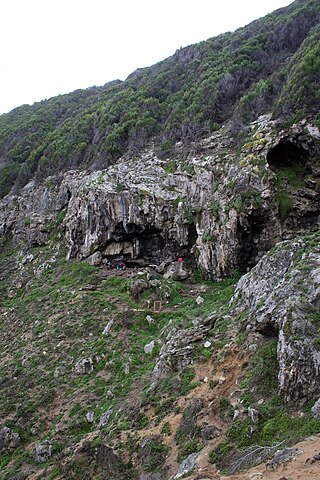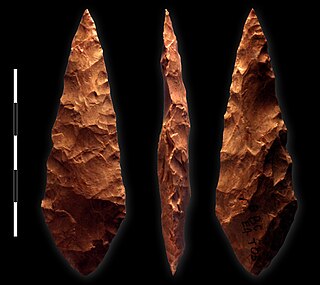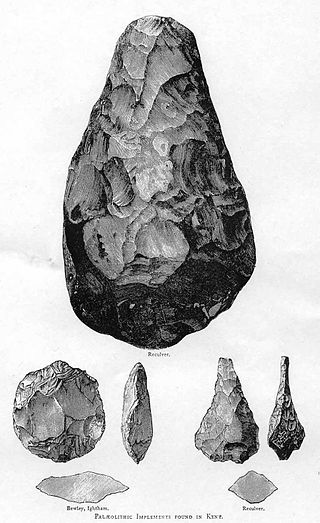Related Research Articles

The bow and arrow is a ranged weapon system consisting of an elastic launching device (bow) and long-shafted projectiles (arrows). Humans used bows and arrows for hunting and aggression long before recorded history, and the practice was common to many prehistoric cultures. They were important weapons of war from ancient history until the early modern period, when they were rendered increasingly obsolete by the development of the more powerful and accurate firearms. Today, bows and arrows are mostly used for hunting and sports.

Behavioral modernity is a suite of behavioral and cognitive traits believed to distinguish current Homo sapiens from other anatomically modern humans, hominins, and primates. Most scholars agree that modern human behavior can be characterized by abstract thinking, planning depth, symbolic behavior, music and dance, exploitation of large game, and blade technology, among others.

Wilton is a term archaeologists use to generalize archaeological sites and cultures that share similar stone and non-stone technology dating from 8,000-4,000 years ago. Archaeologists often refer to Wilton as a technocomplex, or Industry. Technological industries are defined by a common tradition of stone tool assemblages, but these technological industries extend to common cultural behaviors. As such, archaeologists use these industries to define a discrete cultural taxonomy. However, technological industries have the potential to generalize different cultures and communities at regional scales that, in more local settings, are distinguishable in both technology and cultural behaviors.

Africa has the longest record of human habitation in the world. The first hominins emerged 6–7 million years ago, and among the earliest anatomically modern human skulls found so far were discovered at Omo Kibish,Jebel Irhoud, and Florisbad.

Blombos Cave is an archaeological site located in Blombos Private Nature Reserve, about 300 km east of Cape Town on the Southern Cape coastline, South Africa. The cave contains Middle Stone Age (MSA) deposits currently dated at between c. 100,000 and 70,000 years Before Present (BP), and a Late Stone Age sequence dated at between 2000 and 300 years BP. The cave site was first excavated in 1991 and field work has been conducted there on a regular basis since 1997, and is ongoing.
The Stillbay or Still Bay industry was named by archaeologists A. J. H. Goodwin and C. van Riet Lowe in 1929, and is a Middle Stone Age stone tool manufacturing style after the site of Stilbaai in South Africa where it was first described. It may have developed from the earlier Acheulian types. In addition to Acheulian stone tools, bone and antler picks were also used.

The Middle Stone Age was a period of African prehistory between the Early Stone Age and the Late Stone Age. It is generally considered to have begun around 280,000 years ago and ended around 50–25,000 years ago. The beginnings of particular MSA stone tools have their origins as far back as 550–500,000 years ago and as such some researchers consider this to be the beginnings of the MSA.
The Klasies River Caves are a series of caves located east of the Klasies River Mouth on the Tsitsikamma coast in the Humansdorp district of Eastern Cape Province, South Africa. The Klasies River Main (KRM) site consists of 3 main caves and 2 shelters located within a cliff on the southern coast of the Eastern Cape. The site provides evidence for developments in stone tool technology, evolution of modern human anatomy and behavior, and changes in paleoecology and climate in Southern Africa based on evidence from plant remains.

The oldest undisputed examples of figurative art are known from Europe and from Sulawesi, Indonesia, and are dated as far back as around 50,000 years ago . Together with religion and other cultural universals of contemporary human societies, the emergence of figurative art is a necessary attribute of full behavioral modernity.

Sibudu Cave is a rock shelter in a sandstone cliff in northern KwaZulu-Natal, South Africa. It is an important Middle Stone Age site occupied, with some gaps, from 77000 years ago to 38000 years ago.
Howiesons Poort is a technological and cultural period characterized by material evidence with shared design features found in South Africa, Lesotho, and Namibia. It was named after the Howieson's Poort Shelter archaeological site near Grahamstown in South Africa, where the first assemblage of these tools was discovered. Howiesons Poort is believed, based on chronological comparisons between many sites, to have started around 64.8 thousand years ago and ended around 59.5 thousand years ago. It is considered to be a technocomplex, or a cultural period in archaeology classified by distinct and specific technological materials. Howiesons Poort is notable for its relatively complex tools, technological innovations, and cultural objects evidencing symbolic expression. One site in particular, Sibudu Cave, provides one of the key reference sequences for Howiesons Poort. Howiesons Poort assemblages are primarily found at sites south of the Limpopo River.
Howieson's Poort Shelter is a small rock shelter in South Africa containing the archaeological site from which the Howiesons Poort period in the Middle Stone Age gets its name. This period lasted around 5,000 years, between roughly 65,800 BP and 59,500 BP. This period is important as it, together with the Stillbay period 7,000 years earlier, provides the first evidence of human symbolism and technological skills that were later to appear in the Upper Paleolithic.

Border Cave is an archaeological site located in the western Lebombo Mountains in Kwazulu-Natal. The rock shelter has one of the longest archaeological records in southern Africa, which spans from the Middle Stone Age to the Iron Age.

Nelson Bay Cave, previously known as Wagenaar’s Cave, is a coastal archaeological site in the Robberg Nature Reserve on the Robberg Peninsula in Plettenberg Bay, South Africa, about 250 km east of Cape Town. The cave is 18 meters wide and 35 meters deep, and the cave opening is 21 meters above mean sea level. The cave was amongst the first sites excavated in the southern Cape aimed at recording changes in terrestrial fauna caused by changes in climate and sea levels. It documents environmental changes during glacial and interglacial periods. Additionally, the cave is recognized for its Stone Age artifacts that show the transition from Middle Stone Age (MSA) to Later Stone Age (LSA) technologies. It has been regarded as a type-site of the Robberg Later Stone Age Industry.

Boomplaas Cave is located in the Cango Valley in the foothills of the Swartberg mountain range, north of Oudtshoorn, Eden District Municipality in the Western Cape Province, South Africa. It has a 5 m (16 ft) deep stratified archaeological sequence that spans the past 60,000 to 80,000 years, representing discontinuous occupations and hunter-gatherer/herder acculturation. The cave has served multiple functions during its occupation, such as a kraal (enclosure) for animals, a place for the storage of oil rich fruits, and as a home-base for hunter-gatherers. The site's documentation contributed to the reconstruction of palaeo-environments in the context of changes in climate within periods of the Late Pleistocene and the Holocene. Faunal remains and plant material have also been used to reconstruct the diets of the sites occupants. Stone Age adzes have been found at the site, along with lithics from the Wilton, Albany, Robberg, Howiesons Poort industries. Other notable finds include painted marker stones and pottery.

Lucinda Backwell is an archaeologist and a member of the Academy of Science of South Africa. She obtained her MSc in palaeoanthropology from the University of the Witwatersrand Medical School in 2000. Her PhD in palaeoanthropology was awarded in 2004, making her the first South African woman to be awarded a PhD in palaeoanthropology at a local institution.

Francesco d'Errico is an archaeologist who works as CNRS Director of Research at the University of Bordeaux in France and Professor at the Centre for Early Sapiens Behaviour, University of Bergen. In 2014 he was awarded the CNRS silver medal. In 2015 Giorgio Napolitano, president of Italy, presented him with the Fabio-Frassetto prize from the Accademia dei Lincei.
Rose Cottage Cave (RCC) is an archaeological site in the Free State, South Africa, situated only a few kilometers away from Ladybrand, close to the Caledon River, on the northern slopes of the Platberg. RCC is an important site because of its long cultural sequence, its roots in modern human behavior, and the movement of early modern humans out of Africa. Rose Cottage is the only site from the Middle Stone Age that can tell us about the behavioral variability of hunter-gatherers during the Late Pleistocene and Holocene. Berry D. Malan excavated the site between 1943 and 1946, shortly followed by Peter B. Beaumont in the early 1960s, and the most recent excavations occurred from 1987 to 1997 by Lyn Wadley and Philip Harper in 1989 under Wadley's supervision. Humans have inhabited Rose Cottage for over 100,000 years throughout the Middle and Later Stone Ages. Site formation and sediment formation processes at Rose Cottage appear to be primarily anthropogenic. Archaeological research focuses primarily on blade technology and tool forms from the Middle Stone Age and the implications of modern human behavior. Structurally, the cave measures more than 6 meters deep and about 20 by 10 meters. A boulder encloses the front, protecting the cave, but allowing a small opening for a skylight and narrow entrances on both the east and west sides.

The history of Southern Africa has been divided into its prehistory, its ancient history, the major polities flourishing, the colonial period, and the post-colonial period, in which the current nations were formed. Southern Africa is bordered by Central Africa, East Africa, the Atlantic Ocean, the Indian Ocean, and the Sahara Desert. Colonial boundaries are reflected in the modern boundaries between contemporary Southern African states, cutting across ethnic and cultural lines, often dividing single ethnic groups between two or more states.

The prehistory of Southern Africa spans from the earliest human presence in the region until the emergence of the Iron Age in Southern Africa. In 1,000,000 BP, hominins controlled fire at Wonderwerk Cave, South Africa. Ancestors of the Khoisan may have expanded from East Africa or Central Africa into Southern Africa before 150,000 BP, possibly as early as before 260,000 BP. Prehistoric West Africans may have diverged into distinct ancestral groups of modern West Africans and Bantu-speaking peoples in Cameroon, and, subsequently, around 5000 BP, the Bantu-speaking peoples migrated into other parts of Sub-Saharan Africa.
References
- ↑ Wadley 1986.
- 1 2 3 "Lyn Wadley". Witwatersrand University. Archived from the original on 22 December 2014. Retrieved 27 November 2014.
- ↑ "Lyn Wadley". Archived from the original on 14 May 2016. Retrieved 3 May 2015.
- ↑ Mazel, Aaron (1992). "Gender and the hunter-gatherer archaeological record: a view from the Thukela basin". South African Archaeological Bulletin. 47 (156): 122–126. doi:10.2307/3889208. JSTOR 3889208.
- ↑ Wadley, Lyn (1997). "Rose Cottage Cave: archaeological work 1987 to 1997". South African Journal of Science. 93: 439–444. hdl:10520/AJA00382353_84.
- ↑ "Lyn Wadley". maropeng.co.za. Retrieved 27 November 2014.
- ↑ Thomson Reuters list of highly cited researchers.
- ↑ "2019-07 - Prof. Lynn Wadley elected as Fellow of the British Academy". Wits University. 22 July 2019. Retrieved 26 July 2019.
- ↑ Wadley 1987.
- ↑ Wadley & Harper 1989.
- ↑ Wadley 2001.
- ↑ Soriano, Villa & Wadley 2007.